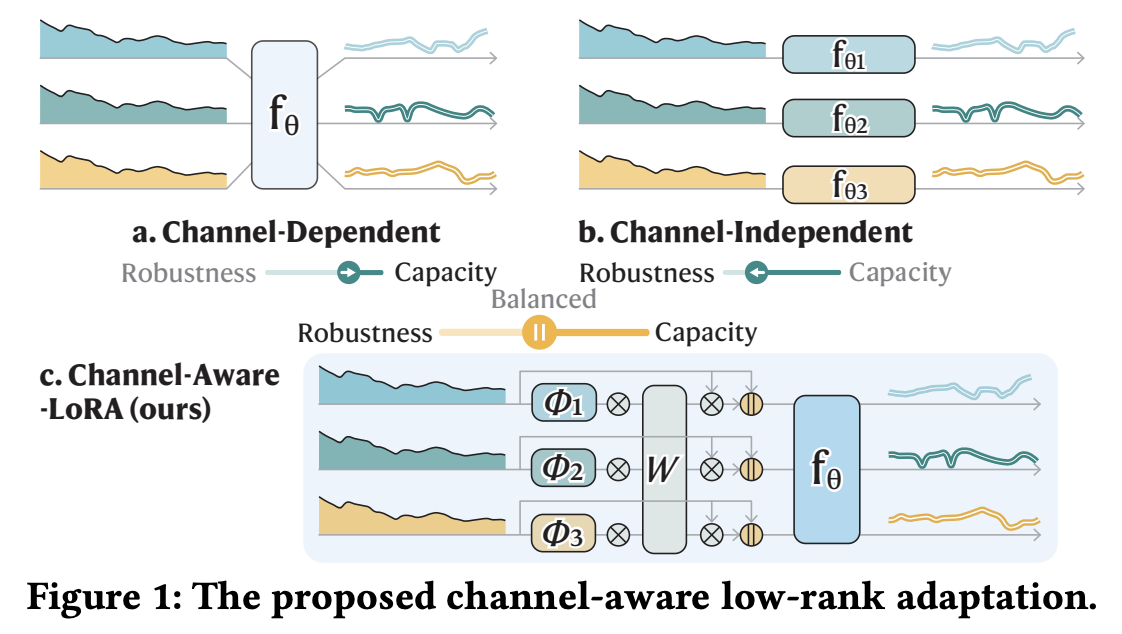Channel-Awaare Low-Rank Adaptation in Time Series Forecasting
Contents
- Abstract
- Preliminaries
0. Abstract
Channel-aware low-rank adaptation
- To balance CI & CD
- How? Condition CD models on identity-aware individual components
- Plug-in solution
1. Introduction

a) Limitation of existing approaches
Group-aware embedding [18]
Inverted embedding [9] for Transformers
Leading indicator estimation [22]
Channel clustering [1]
$\rightarrow$ Either limited to specific types of backbone model
b) Our solution
Background) Low-rank adaptation [5]
Proposal) Channel-aware low-rank adaptation (C-LoRA)
- Trade-off between the two strategies
- Provide an alternative in a parameter-efficient way
Parameterize each channel a low-rank factorized adapter to consider individual treatment
Specialized channel adaptation is conditioned on the series information to form an identity-aware embedding
c) Contribution
- Plug-in solution
- Adaptable to a wide range of SOTA TS model
- No changes to the existing architecture
- Extensive experiments
- Improve the performance of both CD and CI backbones
- Great efficiency, flexibility to transfer across datasets, and can enhance channel identity
2. Methodology
(1) Backbone
General forecasting template
- for both the CI and CD models
Step 1) $\overline{\mathbf{X}}=\operatorname{Normalization}(\mathbf{X})$.
- ex) ReviN: to address the nonstationarity of TS
Step 2) $\mathbf{z}c^{(0)}=\operatorname{TokenEmbedding}\left(\overline{\mathbf{X}}{;}, c\right)$
- $\forall c=1, \ldots, C $.
- usually implemented by MLPs to process temporal features
Step 3) (Optional) $\mathbf{Z}^{(\ell+1)}=\operatorname{ChannelMixing}\left(\mathbf{Z}^{(\ell)}\right)$
- $\forall \ell=0, \ldots, L$.
- optional for CD models by Transformer blocks or MLPs.
Step 4) $\widehat{\mathbf{Y}}=\operatorname{Projection}\left(\mathbf{Z}^{(L+1)}\right)$.
- usually implemented by MLPs to process temporal features
(2) C-LoRA
Revisiting the two strategies
a) CI strategy)
Individual models for each channel
-
Instantiate the TokEnEmbedding with a series of mappings, e.g., different MLPs: $\mathbf{z}c^{(0)}=\operatorname{MLP}_c\left(\overline{\mathbf{X}} ; \theta_c\right), \forall c=1, \ldots, C$.
-
Hypothesis class of all individuals
- $\mathcal{H}_{\mathrm{CI}}={\operatorname{MLP}_c\left(\cdot ; \theta_c\right) \mid \theta_c \in \Theta, c=1, \ldots, C}$.
$\rightarrow$ However, such a hypothesis class is computationally expensive
( + Pure CI models fail to exploit multivariate correlational structures )
b) CD strategy
Expressive by modeling channel interactions
- either explicitly with ChannelMixing or implicitly by optimizing the global loss in Eq. (1).
Limitation
-
(1) Have difficulty capturing individual channel patterns with a shared encoder $\operatorname{MLP}(\overline{\mathbf{X}} ; \theta)$,
-
(2) CM operation
-
can generate mixed channel identity information
$\rightarrow$ Cause an indistinguishment issue [11]
-
c) Combine CI + CD
Channel-wise adaptation in a CD model
Model individual channels in a parameter-efficient way
$\rightarrow$ Low-rank adapter
- Specialized for each channel $\phi^{(c)} \in$ $\mathbb{R}^{r \times D}$, where $r \ll D$ is the intrinsic rank.
How? Condition on another low-rank matrix
- $\widetilde{\phi}^{(c)}=\operatorname{ReLU}\left(\phi^{(c), \mathrm{T}} \mathbf{W}\right) \in \mathbb{R}^{D \times d}$.
- $\mathbf{W} \in \mathbb{R}^{r \times d}$,
- $d$ : adaptation dimension.
- $\widetilde{\phi}^{(c)}$ : channel-specific parameters
- Needs to be aware of the series information to consider the channel identity.
Aggregate all channel adaptations $\mathbf{Z}_\phi^{(0)}=\left\{\mathbf{z}_{c, \phi}^{(0)}\right\}_{c=1}^C \in \mathbb{R}^{C \times d}$ Incorporate it into the global CD models
Final C-LoRA: $\mathbf{Z}^{(0)}=\left[\operatorname{MLP}(\overline{\mathbf{X}} ; \theta) \| \mathbf{Z}_\phi^{(0)}\right] \in \mathbb{R}^{C \times(D+d)}$.
Summary - Balance between CD and CI models - Efificiently integrates global-local components - Adapt to individual channels with the specialized channel adaptation $\mathbf{z}_{c, \phi}^{(0)}$ &Preserve multivariate interactions by the shared $\operatorname{MLP}\left(\overline{\mathbf{X}}_{i, c} ; \theta\right)$. - Reduced hypothesis class is $\mathcal{H}_{\mathrm{C} \text {-LoRA }}=$ $\left\{\operatorname{MLP}\left(\cdot ; \theta, \phi^{(c)}\right) \mid \theta \in \Theta, \phi^{(c)} \in \mathbb{R}^{r \times D}\right\}$,
